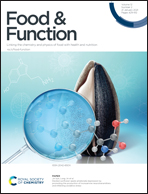Multi-omics reveals the anticancer mechanism of asparagus saponin-asparanin A on endometrial cancer Ishikawa cells†
Abstract
Endometrial cancer (EC) is a malignancy that severely threatens women's health and there is an urgent need to find novel natural compounds as effective treatment drugs. At the same time, multi-omics analysis of cells has been widely used in basic research to find new pathogenesis and mechanisms. Due to the lack of data on the functional importance of mRNAs and miRNAs in plant-derived asparanin A (AA) induced cancer cells, the underlying mechanisms of AA on endometrial cancer (EC) Ishikawa cells were investigated using mRNA-seq and miRNA-seq, qRT-PCR, western blot, and immunohistochemistry. The combined analysis of 37 differentially expressed miRNAs (DEMs) and 489 differentially expressed genes (DEGs) with negative regulatory relationships revealed that AA not only induced apoptosis, but also triggered autophagy through endoplasmic reticulum (ER) stress and DNA damage-related pathways. 23 DEMs and 39 DEGs participated in protein processing in the endoplasmic reticulum (PPER) and p53 signaling pathways, as shown by miRNA–target gene network analyses. Among them, we concluded that miR-6236-p5, miR-1246-p5, miR-11987_L-1, PC-5p-21544, and miR-5100-p3_1ss17TC function as hub miRNAs, and their regulation may be essential for the anti-cancer activity of AA. This study may provide a comprehensive understanding of the potential anticancer regulation of AA on EC, suggesting AA as a potential candidate for dietary supplementation in cancer medication and prevention.



 Please wait while we load your content...
Please wait while we load your content...